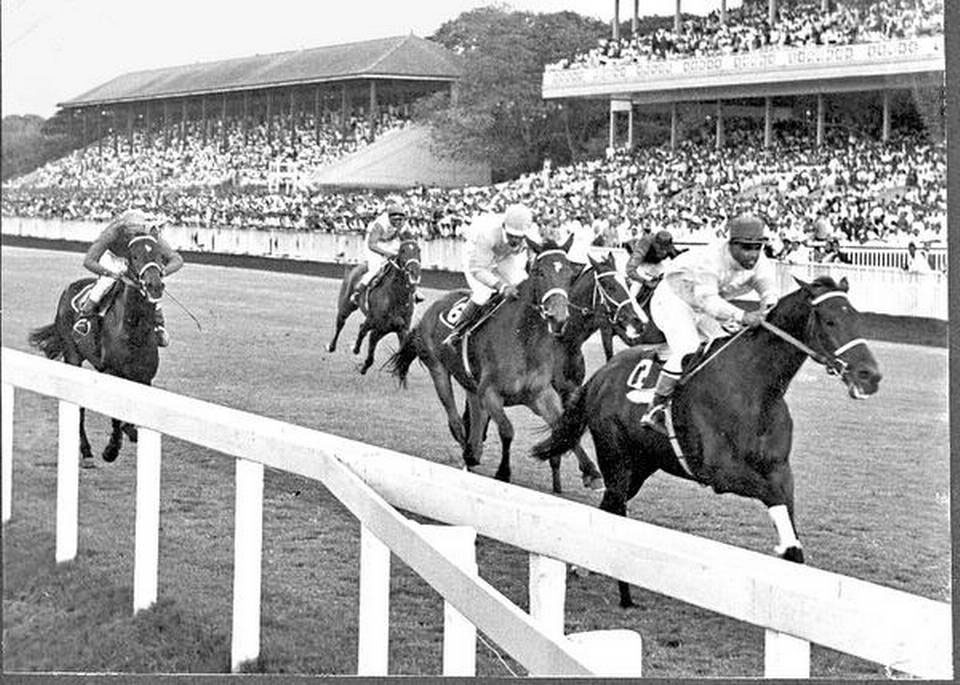Tracing the history of horse racing at Mumbai's Mahalaxmi Racecourse - By Vinayak M. Zodge | The Hindu
Posted on - 30 Jan 2020
Tracing the history of horse racing at Mumbai's Mahalaxmi Racecourse
- By Vinayak M. Zodge | The Hindu
With the 78th Indian derby set to be held at Mahalaxmi Racecourse this weekend, here’s a recap of the history of horse racing in India and the iconic city race track, whose grandstands are considered a heritage structure
 If there is one sport in India which can rival cricket for its die-hard fans and enthusiasts, it is horse racing. While it may pale in comparison to cricket in terms of sheer numbers, horse racing boasts of a longer legacy, and its legion of enthusiasts across the country keep it alive.
If there is one sport in India which can rival cricket for its die-hard fans and enthusiasts, it is horse racing. While it may pale in comparison to cricket in terms of sheer numbers, horse racing boasts of a longer legacy, and its legion of enthusiasts across the country keep it alive.
Over the decades, some horses have attained a cult status and several jockeys and horse owners have achieved fame and fortune. Enthusiasts swear by the thrill of watching an 800-pound animal of pure muscle thundering its hooves across the turf towards the winning post.
Horse racing, like cricket, owes its legacy in India to the country’s British colonial past. The first racecourse was built in 1777 at Guindy in Madras (now Chennai) which is controlled by the Madras Race Club.
While Mumbai’s iconic racecourse at Mahalaxmi was not the original site for racing in the city, the Bombay Turf Club was established and founded by Captain G. Hall, Sir Charles Forbes, A Campbell, P. Hadow and others in 1802. The four founders’ contribution to racing in Mumbai is commemorated annually through races named after them.
The Club had acquired a land parcel in Byculla (a few kilometres from Mahalaxmi) for horse racing and the balcony of a clubhouse was used as a private stand for members. Races were held here for a major part of the 19th century, till 1883, when the racecourse was transferred to a 226-acre plot of reclaimed land known as Mahalaxmi flats.
This huge step forward was taken by the late Sir Cusrow N. Wadia, who had the vision, money and desire to transform a marshland into a showpiece. He advanced an interest-free loan to the club to build the racecourse and grandstands, which were modelled after a racecourse in Melbourne under the supervision of Major J.E.Hughes, the then secretary of the Western India Turf Club. In 1935, the name was changed to the Royal Western India Turf Club (RWITC), after King George V, the then emperor of India, granted permission to add the prefix “royal” to the club’s name.
The Mahalaxmi Racecourse has a 2,400-metre oval racetrack, with the longest straight of 600 m (from final bend up to the winning post) in the country. The beauty of its grandstands, a designated heritage structure, is that the spectators can view the whole mile-and-a-half race by sitting in one place without any obstruction. The racecourse land is now owned by the Brihanmumbai Municipal Corporation and partly the State government.
The betting story
RWITC records show that up to 1912, betting was accepted only by bookmakers. The then government of the presidency thereafter abolished bookmakers and introduced the tote monopoly. The tote is a system of betting based on the use of totalisators managed by the club in which dividends are calculated according to the amount staked rather than the odds offered. After that the common man had easy access to place their bets and footfall at the racecourse increased.
In 1925, an electrically operated tote was installed by the Automatic Totalisators company of Australia. This facilitated the creation of the most popular form of tote betting, the jackpot pool, which was another crowd puller. The pool was an immediate success and in December 1971, a record dividend of over Rs.48 lakh, which was tax-free at that time, was won by Bollywood lyricist Rajendra Kishan.
In recent times, the jackpot pool collection has increased after collections from Mumbai and Pune were combined with those from other centres like Bangalore, Hyderabad and Madras race clubs. In February last year, on the derby day at Mumbai, the jackpot pool reached an all time high, when RWITC added Rs.1 crore to the combined collection. The total collection of the combined jackpot pool on that day swelled to Rs. 2.32 crore.
The common Mumbai-Pune betting totalisator was set up in 1967, where all voice announcements heard at the active centre are relayed to the ghost centre. Further progress was made in 1974, when a pioneering effort in inter-State, inter-venue betting operations was made by accepting betting in Mumbai and Pune on the races held in Bangalore. Currently, the club operates inter-venue betting with all the centres in the country.
The horse’s lineage
The ‘thoroughbred’ used for races is believed to be a chance progeny of the Crusades (a series of religious wars between Christians and Muslims) in the 12th century. Conceptually a British invention, the thoroughbred was genetically of Arabic origin. The knights brought these speedy Arabian steeds with them when they returned from the Crusades.
In the 17th century, the three ancestors of the British thoroughbred — Byerly Turk, Darley Arabian, and Godolphin Arabian — were imported into Great Britain and mated with speedy local mares to produce a brood of foals that became the ‘foundation’ thoroughbreds.
Today, there are over 5,000 thoroughbreds in India. At last year’s post-derby auction sale, a two-year-old thoroughbred colt from Poonawalla Stud Farms fetched a whopping Rs. 25 lakh.
Evening races
A new chapter was added to horse racing in India on January 9, 2016, when evening racing was introduced in the country. This came after the successful preliminary run of the evening races in April 2015, an initiative of Ram Shroff under the leadership of K.N. Dhunjibhoy.
In 2016, Zavaray Poonawalla, chairman of RWITC, won the bid of Rs.1.15 crore as a sponsor to the title rights of evening racing and hosted 19 evening race-days during that Mumbai season. The feature event of the opening day was the ‘Zavaray Poonawalla Evening Racing Triple Million’ — a race which offered Rs. 3 million as prize-money, and a glittering trophy worth Rs.1 million to be presented to the winning connections. Since then, the Mahalaxmi Racecourse is the only racing centre in India where night racing is held and RWITC makes sure to conduct few evening races during the Mumbai racing season every year.
Derby tales
The first Indian Derby was run in 1943 and won by a filly named Princess Beautiful owned by the Maharaja of Baroda and ridden by Australian jockey Edgar Britt. In 1949, Kheem Singh became the first Indian jockey to break the monopoly of foreign jockeys by winning the Indian Derby atop a horse named Balam.
n 1985, the race earned a new avatar after the United Breweries (UB) Group decided to sponsor the mega event and it was named McDowell Indian Derby. In 2016, the event was re-christened as Kingfisher Ultra Indian Derby after the end of the longest alliances in the history of Indian sport. United Spirits Limited, which had been sponsoring the McDowell Indian Derby for more than 30 years, decided to withdraw its sponsorship and United Breweries Ltd. took its place, and has continued its alliance with RWITC for five years now.
Among the owners, trainers and jockeys in the racing fraternity who have won the maximum number of Indian derbies are owner Dr. M.A.M. Ramaswamy with seven winners, trainer Rashid R. Byramji with a record of 11 winners and ace jockey-turned-trainer Pesi Shroff, who achieved the feat of riding eight derby winners as a jockey.
Unparalleled experience
The 2020 Derby will be the 78th renewal of this prestigious event on the Indian racing calendar. The stakesmoney for the Kingfisher Ultra Indian Derby, which is slated to be run on Sunday, stands at Rs. 2.2 crore and the winner will take away around Rs.1.3 crore.
Geoffrey Nagpal, chairman, stewards of the club, RWITC, told The Hindu, “Very few experiences, if any, match the ownership of a top racehorse. As the career of the horse is entwined with the owner’s life for three to four years, planning and decisions like where to run the horse and choosing the right jockey to ride, and above all, achieving the ultimate success are an unparalleled experience. It is unfortunate that the joys of owning a racehorse have not expanded to the new generation of businessmen. This year’s Indian derby is one of the most open in many years. Anyone of six to eight horses out of 20 can win. Good jockeyship will be a key factor.”
When asked about his first Indian derby experience, Mr. Nagpal said, “I witnessed my first derby in 1970, when a horse named Thunder Storm won. It was a wonderful experience. A large crowd looked on as the grey horse thundered down the straight to win this prestigious event.”
Zinia Lawyer, chairman, marketing committee, RWITC, too had an experience to share. “I had an exhilarating experience winning the Indian derby back to back as a co-owner for two years with Enterprising in 1984 and Revelation in 1985. Both the horses were owned by our family — my father late N.M.Irani, myself, my sister Bakhtawar Chenoy — and Maj P.K.Mehra of Usha Stud Farm. Both Enterprising and Revelation were trained by Bezan Chenoy and ridden by jockey P.Shroff,” she said.
Speaking of the stakesmoney, Ms. Lawyer said, “This year’s stakesmoney is little over Rs. 2 crore, but we are trying to increase it and bring it up to around 2.5 crore by next year.”
 If there is one sport in India which can rival cricket for its die-hard fans and enthusiasts, it is horse racing. While it may pale in comparison to cricket in terms of sheer numbers, horse racing boasts of a longer legacy, and its legion of enthusiasts across the country keep it alive.
If there is one sport in India which can rival cricket for its die-hard fans and enthusiasts, it is horse racing. While it may pale in comparison to cricket in terms of sheer numbers, horse racing boasts of a longer legacy, and its legion of enthusiasts across the country keep it alive.